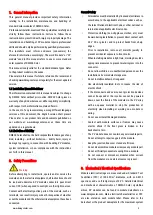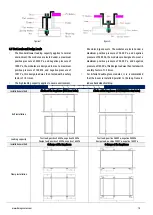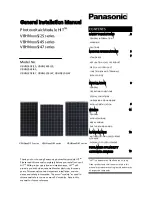
DMEGC Solar PV Modules Installation Manual
•
Use a torque wrench for installation.
•
Do not drill additional holes or modify the module frame.
Doing so will void the warranty.
•
Standard modules can be installed in either landscape or
portrait orientations. Refer to the detailed instructions for
further guidance. Please note that in areas with heavy
snowfall (> 2400 Pa) further countermeasures such the
use of additional support bars should be considered to
avoid snow loads damaging the lowest row of modules.
•
The loads described in this manual correspond to test
loads. For installations complying with IEC 61215 and IEC
61730, a safety factor of 1.5 should be applied for
calculating the equivalent maximum authorized design
loads. Project design loads depend on construction,
applicable standards, location and local climate.
Determination of the design loads is the responsibility of
the racking suppliers and/or professional engineers. For
detailed information, please follow local structural code
or contact your professional structural engineer.
6.1 Mounting Method: Bolting
•
The mechanical load test with these mounting methods
were performed according to IEC 61215.
•
Modules should be bolted to supporting structures
through the mounting holes in the rear frame flanges only.
•
In areas with heavy wind loads, additional mounting
points should be used. The system designer and the
installer are responsible for correctly calculating the
loads and ensuring that the supporting structure meets
all the applicable requirements.
•
Each module must be securely fastened at a minimum of
4 points on two opposite sides.
•
Tightening torques should be
15~20 N•m for M8 coarse
thread bolts, depending on bolt class.
•
The method and the specifications of the fixing parts are
shown in the
figure 3
below:
figure 3
6.2 Mounting Method: Clamping
•
The mechanical load test with these mounting methods
were performed according to IEC 61215.
•
Top or bottom clamping methods will vary and are
dependent on the mounting structures. Please follow the
mounting guidelines recommended by the mounting
system supplier.
•
Each module must be securely fastened at a minimum of
four points on two opposite sides. The clamps should be
positioned symmetrically. The clamps should be
positioned according to the authorized position ranges.
•
Install and tighten the module clamps to the mounting
rails using the torque stated by the mounting hardware
manufacturer. M8 bolt and nut are used for this clamping
method.
•
Tightening torques should be within 18~24
N•m for M8
coarse thread bolts, depending on the bolt class. For the
bolt grade, the technical guideline from the fastener
suppliers should be followed. Different recommendations
from specific clamping hardware suppliers should prevail.
•
The system designer and installer are responsible for load
calculations and for proper design of support structure.
•
DMEGC
Solar’s warranty may be void in cases where
improper clamps or unsuitable installation methods are
found. When installing inter-modules or end-type clamps,
please take the following measures into account:
1. Do not bend the module frame.
2. Do not touch or cast shadows on the front glass.
3. Do not damage the surface of the frame (to the
exception of the clamps with bonding pins).
4. Ensure the clamps overlap the module frame by at
least 7mm but no more than 12mm.
5. Overlap in length by at least 50mm.
6. Ensure the clamp thickness is at least 3 mm.
•
Clamp material should be anodized aluminum alloy or
stainless steel. The mounting details are shown in the
following
figures4
and
figures5
.
Bolt
Flat Washer
Material: stainless steel
size: M8*20mm
Material: stainless steel
size: M8
thickness: ≥1.6mm
Spring Washer
Nut
Material: stainless steel
size: M8
thickness: ≥2.0mm
Material: stainless steel
size: M8


































